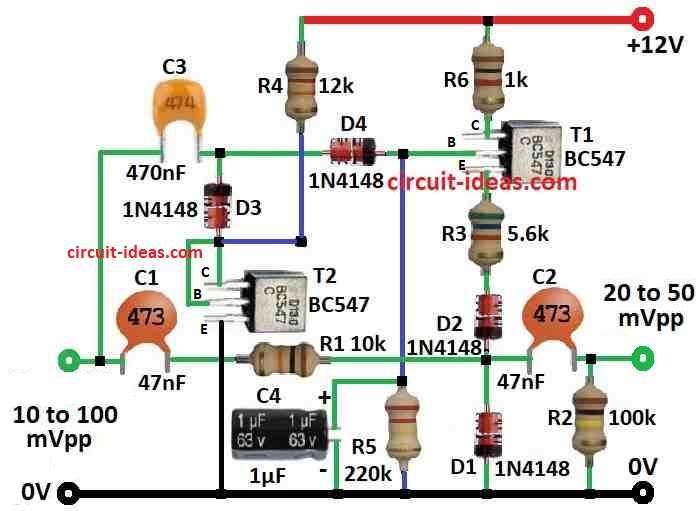Think like music have one volume knob.
Range that is dynamic? It is how far volume go from very soft to very loud.
Audio Compressor Circuit does this job it move knob by itself.
When sound is too loud it make little lower and when it is too quiet it push it little louder.
So all sound come more same level which is not too loud not too soft.
Good for music or sound where volume go up-down too much.
Circuit Working:

Parts list:
| Component | Quantity |
|---|---|
| Resistors (All resistors are 1/4 watt unless specified) | |
| 10k | 1 |
| 100k | 1 |
| 5.6k | 1 |
| 12k | 1 |
| 220k | 1 |
| 1k | 1 |
| Capacitors | |
| Ceramic 47nF | 2 |
| Ceramic 470nF | 1 |
| Electrolytic 1µF 25V | 1 |
| Semiconductors | |
| Transistor BC547 | 2 |
| Diodes 1N4148 | 4 |
This audio compressor circuit uses only one main part and that is T1 transistor.
Audio connects through C1, R1, D1 and then C2 and R3.
Same times small part of audio connects to D3 and D4 and these make control voltage for T1.
How fast volume fade or change? that depends on C4 and R5.
Even if audio input change a lot like 50dB the output will stay around plus minus 3dB.
This circuit works good in transmitter use.
Formula:
This design controls the audio signal gain based on how loud it is.
This way we can make a Audio Compressor Circuit.
It reduces the dynamic range and loud sound become less loud and quiet sound become little louder.
How to find Compression Ratio:
Compression ratio (R) tell us how much signal strength go down after some loud limit.
Formula is:
R = Vout / Vin
where:
- Vout is output audio level (after compression)
- Vin is input audio level (before compression)
To control this ratio we can change transistor bias and feedback parts.
This circuit uses BC547 transistors and give base idea how to make audio compressor.
We can adjust it more for better sound or for special audio need.
How to Build:
To build a Audio Compressor Circuit follow the below steps for connections:
- Connect audio input to capacitor C1.
- C1 removes any DC part from the signal.
- Then connect resistor R1 with C1 and C2 in line.
- R1 stops too much current from going to base of transistor T1.
- Put diode D1 next to R1 in parallel
- D1 helps change AC signal to DC to rectify
- Connect capacitor C2 with resistor R3 side by side in parallel
- C2 makes rectified signal smooth.
- Connect emitter of T1 to ground.
- This gives good path for current.
- Put resistors R3 and R5 in line in series from T1s collector to positive power.
- This control voltage and signal path.
- Add diodes D3 and D4 next to R5 in parallel
- These work like part of signal detector.
- Put capacitor C4 also with D3 and D4.
- C4 set how long fading happen.
- Take output from both ends of resistor R5.
- That is the final signal out.
- Turn ON power but check voltage and polarity first.
- Be sure all is safe and right.
Note:
- Use correct values for components based on ones audio need.
- Also grounding and insulation must be good to avoid noise or shock.
Conclusion:
A Audio Compressor Circuit is often used in audio recording, mixing and for broadcasting.
It help make sound better, control loud and soft parts and stop audio gear from getting too much signal.
Also it is used in music instruments, sound systems and telecom equipment.
Check sound stay clear, same level and easy to hear.
Leave a Reply